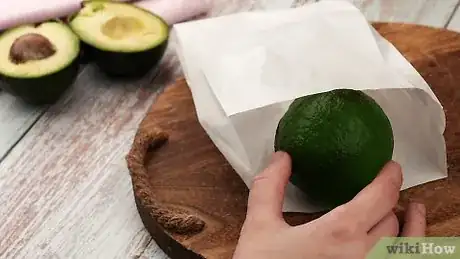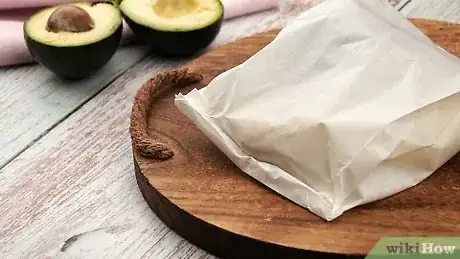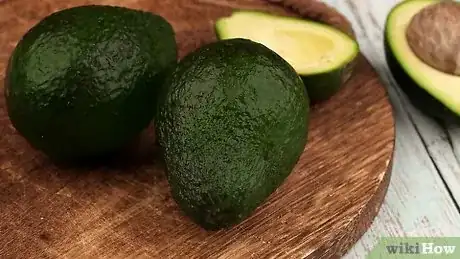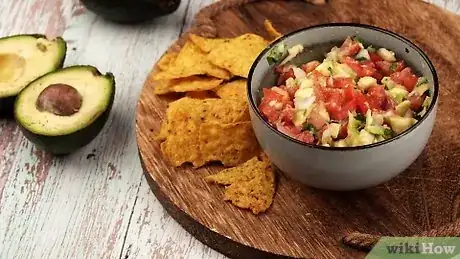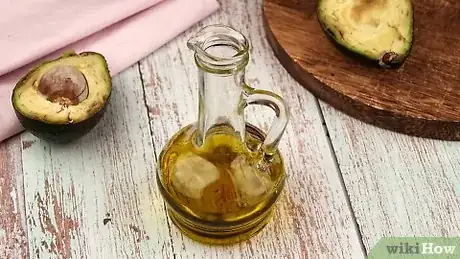This article was co-authored by Jennifer Levasseur. Chef Jennifer Levasseur is a Personal Chef and the Owner of The Happy Cuisiniere based in Breckenridge, Colorado. She has over 12 years of culinary experience and specializes in Mountain and Contemporary Rustic cuisine. Moreover, she can craft dishes and modify menus to accommodate dietary restrictions, such as gluten-free, vegetarian, vegan, pescatarian, and dairy-free diets. In addition to a Bachelor’s degree in Marketing and Management from the University of Houston, Chef Jennifer holds Associate’s degrees in Culinary Arts and Baking & Pastry Arts from Houston Community College.
There are 10 references cited in this article, which can be found at the bottom of the page.
wikiHow marks an article as reader-approved once it receives enough positive feedback. In this case, several readers have written to tell us that this article was helpful to them, earning it our reader-approved status.
This article has been viewed 176,953 times.
Avocados are a rich, creamy, and delicious fruit that can be eaten alone, made into spreads and dips, or even turned into tasty desserts. Unlike most fruits, avocados don't ripen on the tree, but rather after they've been harvested. That's why it's so common to buy unripe avocados from the grocery store. Luckily, there are a couple of ways you can speed up the ripening process if you need to use your avocados quickly, and different ways to store avocados that are at different stages of ripeness.
Steps
Speeding up the Ripening Process
-
1Place unripe avocados in a paper bag. Avocados will naturally ripen on their own at room temperature on the counter. You can also speed up the ripening process so the avocados will be ready to use in two to three days.[1] To hasten the ripening, put the avocados into a paper bag and fold the top of the bag over on itself twice.
- Avocados naturally create something called ethylene gas, which makes fruit ripen faster. When the avocados are in a paper bag, the ethylene gas gets trapped, and this helps to ripen the fruit faster than if the gas escaped into the air.[2]
-
2Add a ripening agent. There are other fruits that produce ethylene gas, and you can help speed up the ripening process even more by adding other ethylene-producing fruits to the paper bag with the avocado. Other fruits to consider include:[3]
- Red or golden delicious apples
- Kiwi
- Banana
Advertisement -
3Give the avocados a couple of days to ripen. Place the avocados somewhere warm, like on the counter near a sunny window. Check them after two days to determine if they're ripe. If they still need more time, close the bag again and leave the avocado for another day.
- Non-bagged avocados generally need four to seven days to ripen, but bagged avocados may be ready in two to three.[4]
- Ripening an avocado in a bag won't affect the flavor, and will result in a delicious and buttery fruit.
-
4Know when an avocado is ripe. There are two main indications that an avocado is ripe, and they are color and texture. First, check the color. The skin of a ripe avocado will turn a deep greenish-black. Next, give the fruit a gentle squeeze. A ripe avocado will yield to gentle pressure.
- An unripe avocado will have light or dark green skin and will feel firm when squeezed.
- An overripe avocado will be dark black, look slightly shrunken, and will feel mushy when squeezed.[5] When you cut into an overripe avocado, the flesh will have turned brown in many spots.
Softening Avocados Rapidly
-
1Preheat your oven. There are times when you'll need a ripe avocado immediately and simply don't have one. In those cases, you can heat the avocado in the oven to help soften them. Preheat the oven to 200 F (93 C).
- The oven is superior to the microwave for ripening avocados rapidly. The microwave can leave the avocado mushy and tasteless.
- An avocado that's softened in the oven won't have the same buttery flavor that a truly ripe avocado does, but it will be softer and easier to peel, cut, and mash.[6]
-
2Wrap the avocado in foil. Baking the avocado in the oven will help it to produce ethylene, which is a gas produced by many plants that promotes ripening. To trap that gas and help the avocado soften, wrap the avocado in aluminum foil.[7]
- Instead of using foil, you can also place the avocado in a baking dish with a tight-fitting lid. This is particularly useful if you're trying to soften multiple avocados.
-
3Bake the avocado. Place the avocado in the oven and bake it for an hour. Any less and the avocado won't be soft enough to pass as ripe. When the hour is up, remove the avocado from the oven. Give it a gentle squeeze through the foil to test for softness. Return the avocado to the oven for 10-minute increments if it still feels firm.
- When the avocado is soft and gives to gentle pressure, set it aside and let it cool in the foil.
-
4Remove the foil before using. Once the avocado has cooled to the touch, about 30 minutes, remove the foil. Now that the avocado is soft, you can cut it, mash it, or add it to any of your favorite dishes.[8]
Storing Avocados
-
1Keep unripe avocados on the counter. Avocados don't ripen until they've been picked, so you can store unripe avocados at room temperature on your counter for up to seven days while they ripen.
- Place unripe avocados in a fruit bowl or basket and store them at room temperature. You can either leave them on the counter or put them away in a pantry.[9]
- Start checking for ripeness after three or four days.
-
2Refrigerate ripe avocados. Ripe avocados should be transferred to the refrigerator if they aren't being used immediately. Refrigeration will slow the ripening process. Ripe avocados can be stored at cool temperatures for between three and five days.
- Refrigerated avocados should be stored in a plastic bag.[10]
-
3Prevent cut avocados from turning brown. As soon as you cut into an avocado, regardless of whether it's ripe or not, the green flesh inside will begin to turn brown. This happens with many fruits, and it's a result of being exposed to oxygen. To help slow the process, store the avocado in the refrigerator for one to two days. You can further slow the process by:[11]
- Storing the avocado in an air-tight container with some chopped onion.
- Wrapping the avocado tightly with plastic wrap, with the wrap touching the flesh.
- Sprinkling cut or mashed avocado with an acidic agent, such as lemon or lime juice, tomato juice, orange juice, or vinegar. Store the fruit in an air-tight container.
-
4Freeze avocados for long-term storage. Ripe avocado can be stored in the freezer for up to six months. To prepare the fruit, peel the avocado, remove the pit, and dice the flesh into small cubes. Sprinkle the cubes with ½ tablespoon (10 ml) of lemon or lime juice. Transfer to an air-tight container and place it in the freezer.
- As an alternative, you can also puree the avocado with lemon juice and freeze the puree.[12]
- To soften avocados quickly, freeze them and immediately thaw them.
Using Avocados
-
1Whip up some guacamole. Guacamole is an avocado-based dip that was created by the Aztecs. This creamy dip is made by mashing an avocado and mixing it with tomato, citrus juice, and spices. Guacamole can be eaten a number of ways, including:
- Dip for potato chips
- Spread for sandwiches
- Stuffed into potatoes or boiled eggs
- As a sauce for fish, chips, and other fried foods
- On bread or toast
-
2Make an avocado facial mask. Avocado can be made into a DIY beauty face mask that moisturizes and nourishes the skin. Along with making your skin soft and smooth, it may also help it look younger, since avocado contains retinol, which can promote cell growth and collagen production.[13]
-
3Roll up some avocado sushi. Avocado is a popular ingredient in many types of vegetarian sushi, and you can make a tasty meal, delicious snack, or yummy party food by creating your own avocado sushi.
- To give your avocado sushi rolls an extra crunch, batter the avocado, dip it in bread crumbs, and deep fry it before rolling it up.
-
4Make a soup. Avocado may not be the first ingredient people think of when it comes to soup, but avocado and lime soup is a zesty, refreshing, and creamy soup that you can eat as an appetizer or a whole meal.
- There are many variations of avocado soup, including creamy soups where the avocado is pureed, and hearty soups where the avocado is in chunks. Creamy avocado soup can be served warm or cold.
-
5Press your own oil. Avocado is full of healthy fats, which means it's relatively easy to make avocado oil in your own kitchen. Avocado oil can be used for cooking, making bath products, as a skin moisturizer, and as an ingredient in makeup and cosmetic products.
-
6Stuff them. Avocados can be cut in half and stuffed just like jacket potatoes and deviled eggs. You can make stuffed avocados with meat, seafood, vegetables, dips, and even eggs. The stuffed avocados can be served cold, warm, grilled, baked, and in a number of other ways.
Community Q&A
-
QuestionDo avocados get ripe in the refrigerator?
 Community AnswerTo ripen avocados, keep them warm and wrapped, in a cupboard. Alternatively, place them in the sunshine.
Community AnswerTo ripen avocados, keep them warm and wrapped, in a cupboard. Alternatively, place them in the sunshine.
References
- ↑ http://www.californiaavocado.com/blog/how-to-ripen-an-avocado
- ↑ https://www.thrillist.com/eat/nation/how-to-ripen-avocados-fast-the-quickest-methods-tested
- ↑ http://www.californiaavocado.com/blog/how-to-ripen-an-avocado
- ↑ http://www.stilltasty.com/questions/index/127/page:1
- ↑ https://www.avocadocentral.com/how-to/how-to-pick-how-to-buy-avocados
- ↑ http://www.thekitchn.com/can-you-really-ripen-an-avocado-in-just-10-minutes-223006
- ↑ http://www.purewow.com/food/how-to-ripen-an-avocado
- ↑ http://www.thekitchn.com/can-you-really-ripen-an-avocado-in-just-10-minutes-223006
- ↑ https://www.thekitchn.com/best-place-to-store-avocados-i-150613
About This Article
To ripen and store avocados, leave them on your counter at room temperature for 7 days. If you need them to ripen in 2-3 days, put them in a paper bag and fold the top of the bag over twice to trap ethylene gas inside. You can also put other ethylene-producing fruits, like red apples and kiwi, inside the bag. You'll know an avocado is ripe when the skin turns deep greenish black and it yields to pressure when gently squeezed. Transfer ripened avocados to the fridge if you're not using them right away. If you want to learn how to store your avocados in the freezer, keep reading!
